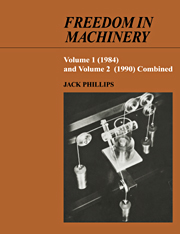Book contents
- Frontmatter
- Dedication
- Contents
- Preface
- General introduction
- 1 Mechanism and the mobility of mechanism
- 2 Overconstraint and the nature of mechanical motion
- 3 Some of the various lines in a moving body
- 4 Enumerative geometry and the powers of infinity
- 5 Rigidity and the instantaneous screw axis
- 6 Irregularity and the freedoms within a joint
- 7 The possibilities in reality for practical joints
- 8 Some elementary aspects of two degrees of freedom
- 9 The linear complex of right lines in a moving body
- 10 Line systems and the dual vectors in mechanics
- 11 Geometrical properties of the linear line systems
- 12 The vector polygons for spatial mechanism
- 13 On the two theorems of three axes
- 14 Some reciprocities across the middle number three
- 15 The generality and the geometry of the cylindroid
- 16 The discovery in a mechanism of a cylindroid
- 17 Action, notion, clearances and backlash
- 18 Singular events in the cycles of motion
- 19 Fundamental relations and some algebraic methods
- 20 The special geometry of some overconstrained loops
- 21 The helitangent lines in a moving body
- 22 The cylindroid in gear technology
- 23 The general and the special screw systems
- Bibliography
- Index of proper names
- Subject Index
6 - Irregularity and the freedoms within a joint
Published online by Cambridge University Press: 07 September 2010
- Frontmatter
- Dedication
- Contents
- Preface
- General introduction
- 1 Mechanism and the mobility of mechanism
- 2 Overconstraint and the nature of mechanical motion
- 3 Some of the various lines in a moving body
- 4 Enumerative geometry and the powers of infinity
- 5 Rigidity and the instantaneous screw axis
- 6 Irregularity and the freedoms within a joint
- 7 The possibilities in reality for practical joints
- 8 Some elementary aspects of two degrees of freedom
- 9 The linear complex of right lines in a moving body
- 10 Line systems and the dual vectors in mechanics
- 11 Geometrical properties of the linear line systems
- 12 The vector polygons for spatial mechanism
- 13 On the two theorems of three axes
- 14 Some reciprocities across the middle number three
- 15 The generality and the geometry of the cylindroid
- 16 The discovery in a mechanism of a cylindroid
- 17 Action, notion, clearances and backlash
- 18 Singular events in the cycles of motion
- 19 Fundamental relations and some algebraic methods
- 20 The special geometry of some overconstrained loops
- 21 The helitangent lines in a moving body
- 22 The cylindroid in gear technology
- 23 The general and the special screw systems
- Bibliography
- Index of proper names
- Subject Index
Summary
On regularity, and the irregularity at surfaces
01. The idea that regularity is a possibility derives directly from the foundations of Euclidean geometry. We allow by it such concepts as the straightness of a straight line, the flatness of a plane, the sphericality of a sphere. We can extend the notion to allow in the imagination such other things as, the exact ellipticality of a plane section through an ellipsoid, or the exact equi-angularity at the apices of some regular polyhedron. Extending the meaning of regularity into the realm of joints, we can envisage if we wish, and please refer to figure 6.01, that the convex conical surface at the joint element on link 1 and the flat plane surface at the joint element on link 2 can make, with one another, continuous line contact. We can similarly imagine that the convex surface of the accurately constructed spherical ball on 2 can make, with the concave surface of the matchingly constructed, equi-radial, spherical socket sunk in 3, continuous surface contact. These and other such imagined, continuous contacts between a pair of joint elements in mechanism – they are not single point contacts or even multiple point contacts but contacts involving ∞1or ∞2 of points – can exist in our imaginations only by virtue of the wholly idealised, but well established concepts due to Euclid.
02. But we know that no mould can ever exactly fit its pattern, that no casting can ever exactly fit its mould, that no welded construction ever matches its production drawing, and that no subsequent machining is ever done on any job accurately.
- Type
- Chapter
- Information
- Freedom in Machinery , pp. 76 - 103Publisher: Cambridge University PressPrint publication year: 2007



